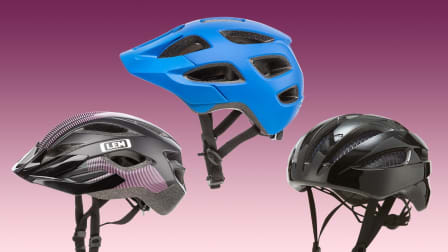When You Really Need to Replace Your Bike Helmet
You should always replace a bicycle helmet after a crash, but there are several other key reasons to replace an old helmet
When you shop through retailer links on our site, we may earn affiliate commissions. 100% of the fees we collect are used to support our nonprofit mission. Learn more.

There are plenty of great reasons to hop on a bike, whether you’re training for a race, trying to make your commute to work healthier, or just trying to get out for some fresh air. No matter why you’re riding, though, you should always be wearing a bike helmet.
But if it has been stashed on a basement or garage shelf for a while, you may wonder whether you need to replace your helmet and whether it’s still as protective as it was when you first brought it home.
Wearing a helmet is associated with almost a 70 percent lower risk of serious head injury in bicycling crashes, but helmets aren’t indestructible. One thing experts agree on is that after a crash, you need to replace your bike helmet as soon as possible.
“A helmet can look fine after a crash,” says Susan Booth, who has been involved with Consumer Reports’ bike helmet testing. The foam that absorbs the impact may have compressed or cracked in a way that isn’t easy to see. “Once that foam is compressed, you are reducing the safety margin you have,” she says. “That’s going to reduce the helmet’s ability to protect you.”
How Often Should You Replace Your Bike Helmet?
CR recommends following manufacturer recommendations or getting a new bicycle helmet every five years or so because of the ways a helmet can get beaten up over time, according to Booth. A heavily used helmet is going to be exposed to ultraviolet light from the sun, and it might be repeatedly tossed into a locker or a car, where summer temperatures can top 120° F.
A beaten-up, worn-out helmet will protect you better than not wearing one, according to Booth, but eventually, you’ll want to replace it.
Depending on where and how it’s used, a helmet will be exposed to different levels of wear and tear, as well as specific environmental conditions (heat and humidity). These collectively may alter impact performance, says Barry Miller, PhD, director of outreach and business development for the Virginia Tech Helmet Lab. The lab tests helmets for a variety of sports and conducts research into how helmets can reduce risks of brain injury.
“A used helmet may not perform to the same level as a new helmet due to how the impact material degrades over time and the specific environmental conditions it was exposed to,” Miller says.
But “the more important reason to upgrade your helmet is due to the technology and performance advances,” he says. Additionally, newer helmets may fit better and be more comfortable, and they’re more likely to come with technologies/materials designed to reduce what are known as rotational forces, which contribute to concussion risk. (See CR’s explainer on rotational force mitigation in bike helmets.)
If your helmet has been through the wringer, or if you just want the latest in safety technology, a new helmet may be in order.
The Case for Hanging On to a Bike Helmet Longer
While you might want a new bike helmet for stylistic reasons, ventilation, or newer technology, you don’t necessarily need to replace a well-cared-for helmet for safety reasons alone, according to Swart. That recommendation is largely based on research conducted by engineering firm MEA Forensic, which found in tests of hundreds of helmets that age did not significantly affect the performance of the protective foam in helmets up to 26 years old.
But while the foam in a helmet doesn’t necessarily wear out, other aspects could, including the straps, the adjusters that help you tighten the helmet, and the hard plastic exterior shell. Many of those features are essential for ensuring a secure fit. If the colors have started to fade from sun exposure, that’s likely a sign that the exterior could have been weakened by sun exposure over time, Swart says.
If your helmet is still in good condition and you are concerned about sustainability—and your helmet potentially making its way into a landfill—then Swart says to hold on to it for a bit longer. Research has shown its protection is probably as good as the day you bought it. If you have a reason to get a new helmet, though, you should, he says.
Ready for an upgrade? Here are some CR picks for helmets in a variety of budget levels, from most expensive to least expensive.






















































































